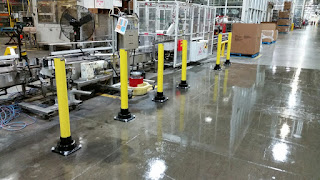Safety bollards protect site workers and the general public alike from accidents, vandalism, and crime. Statistics show that many devastating workplace injuries are caused by errant vehicle traffic. Safety bollards decrease the likelihood of injuries in the following ways:
- By creating a physical barrier between people and sources of danger – Safety bollards vary greatly in size and strength, from short steel posts to massive concrete structures. Yet they’re remarkably similar in their ability to repel danger. This makes them an excellent shield against all types of hazards, from stray vehicles to terrorist attacks. Yet they need not look imposing or intimidating. In fact, they often do double duty as planters, statues, fountains, entryways, and other decorative public works.
- By serving as a deterrent to both careless behavior and deliberate acts of destruction – Safety bollards are powerful visual reminders that an area is off-limits to vehicles, human beings, or both. In today’s information-saturated society, thousands of messages compete for everyone’s attention on a daily basis. Safety bollards remind passersby that they should pay attention to their surroundings. They also serve as a warning to those who would cause harm on purpose.
- By channelizing traffic away from sensitive areas – For example, walking and biking paths are increasingly common sights across the country as people place greater emphasis on personal fitness. As they do, however, the need to make motorists aware of their presence grows as well. Safety bollards serve this purpose, helping to keep car and foot traffic separate. They do the same for pedestrian walkways, construction zones, and entrances to public facilities.
Today’s world offers unprecedented opportunities for education, income, and personal enrichment. Along with these advances, however, comes expanding infrastructure and an increasing need to safeguard human beings from harm, be it intentional or otherwise. Safety bollards play a crucial role in these efforts. As the planet grows more interconnected, the need for these structures will only increase. Public officials and private business owners should keep this fact in mind as they strive to make their locations safer.
Originally Posted HERE.





















